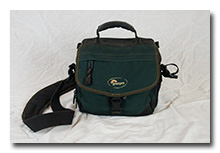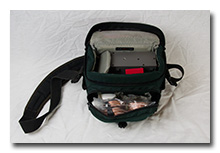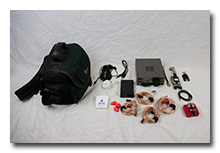by William Eric McFadden
The K1 Travel Kit is a small but complete low-power, CW-only, HF station in a rugged and weather-resistant LowePro Nova 1 camera bag. The K1 Travel Kit is designed for transport by bicycle or foot.
The K1 Travel Kit is currently under development. Photos may not represent the current state of the station. This page will change as various ideas are tested and accepted or rejected.
-
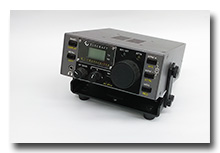 The heart of the K1 Travel Kit is an Elecraft K1
CW-only, low-power transceiver equipped with the KFL1-4 four-band module providing
coverage of 40, 30, 20, and 15m; the KAT1 internal automatic antenna tuner module;
and the KNB1 noise blanker module.
The heart of the K1 Travel Kit is an Elecraft K1
CW-only, low-power transceiver equipped with the KFL1-4 four-band module providing
coverage of 40, 30, 20, and 15m; the KAT1 internal automatic antenna tuner module;
and the KNB1 noise blanker module.
This four-band K1's frequency coverage (40, 30, 20, 15m), high performance receiver, generous feature-mix, small size, low weight, and battery-friendly design make it a good field-radio for a CW operator.
-
The K1 can operate over a voltage range of 8.5vdc to 15vdc. My K1 is not equipped with the KBT1 internal battery option so I must power my K1 with an external power source.
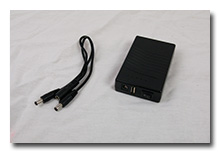 Originally the K1 Travel Kit included a Talentcell 12v 3000mAh lithium ion battery pack
(link).
While this small, lightweight, and inexpensive LiPO battery is called by its manufacturer a "12 volt battery",
the battery, which is made up of three 3.7v LiPO cells connected in series, is actually an 11.1v
battery. However, 11 volts is more than enough to keep the K1 happy and the battery should have
sufficient capacity to power the K1 for several hours in the field. As a bonus, the Talentcell battery
also includes a USB port which can be used to power or charge a smartphone or tablet, if needed,
even while the battery is powering the K1.
Originally the K1 Travel Kit included a Talentcell 12v 3000mAh lithium ion battery pack
(link).
While this small, lightweight, and inexpensive LiPO battery is called by its manufacturer a "12 volt battery",
the battery, which is made up of three 3.7v LiPO cells connected in series, is actually an 11.1v
battery. However, 11 volts is more than enough to keep the K1 happy and the battery should have
sufficient capacity to power the K1 for several hours in the field. As a bonus, the Talentcell battery
also includes a USB port which can be used to power or charge a smartphone or tablet, if needed,
even while the battery is powering the K1.
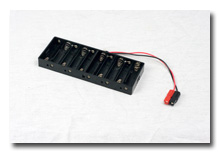 Now, I carry a rugged ten AA-cell holder
(Batteries America p/n 10AAT, photo | link)
I can fill with ten 1.2v NiMH cells or, in a pinch, eight alkaline cells
(1.5v, 2.2 - 2.7Ah) or lithium primary cells (1.5v, 2.8 - 2.9Ah) plus
two dummy cells. Either way they're configured, these packs are nominal 12-volt
packs. I am currently using a set of ten Sanyo/Panasonic Eneloop 1900mAh NiMH cells
with this battery-holder. (See KX1 Mini Travel Kit
for a discussion on spring-type AA-cell holders.)
Now, I carry a rugged ten AA-cell holder
(Batteries America p/n 10AAT, photo | link)
I can fill with ten 1.2v NiMH cells or, in a pinch, eight alkaline cells
(1.5v, 2.2 - 2.7Ah) or lithium primary cells (1.5v, 2.8 - 2.9Ah) plus
two dummy cells. Either way they're configured, these packs are nominal 12-volt
packs. I am currently using a set of ten Sanyo/Panasonic Eneloop 1900mAh NiMH cells
with this battery-holder. (See KX1 Mini Travel Kit
for a discussion on spring-type AA-cell holders.)
Note to Self: W1PID is using a PowerFilm LightSaver and a Baofeng USB to 10V Smart Charger to power an MTR-4B transceiver (link). The LightSaver (link) solar panel charges an internal 3200mAh battery and outputs 5vdc to a USB port. The Baofeng USB to 10V Smart Charger (link) converts 5vdc from a USB port to 10vdc. The K1 can operate with a supply voltage as low as 8.5vdc so such a scheme might work with the K1. While both the LightSaver and the Baofeng are limited to 500mA output, W1PID says his scheme works with the MTR-4B because at reduced voltage the MTR-4B produces lower output power and draws less current. The K1 should behave similarly.
-
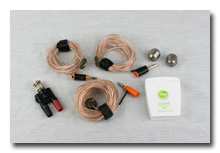 The K1 Travel Kit includes a proven 28½' end-fed wire and three 17' counterpoise wires.
This is the same antenna I've used successfully with my KX3 for hundreds of National Parks on the Air
(NPOTA) and Parks on the Air (POTA) activations. I feed this antenna, without feedline, through a
BNC-to-dual-banana adapter or, sometimes, a 4:1 impedance transformer. The KAT1 autotuner in the K1
can easily find a match for this antenna on all four bands.
The K1 Travel Kit includes a proven 28½' end-fed wire and three 17' counterpoise wires.
This is the same antenna I've used successfully with my KX3 for hundreds of National Parks on the Air
(NPOTA) and Parks on the Air (POTA) activations. I feed this antenna, without feedline, through a
BNC-to-dual-banana adapter or, sometimes, a 4:1 impedance transformer. The KAT1 autotuner in the K1
can easily find a match for this antenna on all four bands.
To hang the 28½' wire in a tree, I carry a 100-yard spool of dental floss and a couple of large fishing weights. When I don't want to fuss with throwing a line through trees, I use an inexpensive Goture Red Fox 7.2m carbon-fiber telescoping fishing pole that I strap to an existing post or place in a homebrew spike and deploy the 28½' wire either as a sloper or as an inverted-vee. I have removed the top three sections from the Red Fox because they're really too whippy to support a wire, leaving an 18' 3½" mast. The Red Fox and spike do not fit in the LowePro Nova 1 bag; they need to be carried separately.
-
The K1 has a perfectly adequate built-in memory keyer so I don't need to carry an external memory keyer with the K1 Travel Kit.
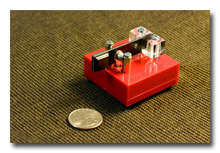 To key the K1, I use a very lightweight Whiterook MK-33 single-lever paddle (photo | link)
to which I've added an internal switch which allows me to use the key as a
keyer paddle or as a manual sideswiper/cootie key.
To key the K1, I use a very lightweight Whiterook MK-33 single-lever paddle (photo | link)
to which I've added an internal switch which allows me to use the key as a
keyer paddle or as a manual sideswiper/cootie key.
A sideswiper/cootie key is my key of choice, even when I'm operating in the field, but the ability to use the modified MK-33 as a keyer paddle means I retain the ability to program the K1's memory keyer while in the field—a memory keyer programmed to call "CQ" is a marvelous and useful thing when one is running a frequency while performing a Parks on the Air activation or participating in a QRP field contest.
-
Using Acrobat Reader and an available duplex color printer, I printed the K1 Owner's Manual in half-size "booklet" form. This booklet fits nicely in the outside rear pocket of the Nova 1 bag.
-
The carrying case is a repurposed LowePro Nova 1 camera bag. This well-padded and rugged bag accommodates the K1 transceiver, the battery, the key, earbuds, antenna, unun or balun, cables, manual, and other items. While not fully waterproof, the bag should provide sufficient protection for the K1 while in transport from all but the heaviest rain.
-
I built the K1 Travel Kit to encourage me to engage in human-powered-transport field operations, in particular, for the annual Adventure Radio Society Flight of the Bumblebees event.
Biking-
Long ago, when I originally used a different LowePro Nova 1 as a camera bag, I had built an easy-to-mount, easy-to-remove, rear-rack-fixture for my bicycle to allow me to safely carry the camera bag. This same fixture now allows me to safely carry the K1 Travel Kit on the bicycle. A pannier hanging on the other side of the bicycle is used to carry a clipboard with copy-paper and logsheets, the Goture Red Fox pole and stake, and a towel1.
I've used the K1 Travel Kit to perform bicycle-portable POTA activations of...
- Zaleski SF (K-5455) + Lake Hope SP (K-1968) on 2022-06-10
- Zaleski SF (K-5455) + Lake Hope SP (K-1968) on 2022-06-03
- Wayne National Forest (K-4521) + FoBB 2021 on 2021-07-25
- Wayne National Forest (K-4521) on 2021-07-10
-
The removable shoulder strap on the LowePro Nova 1 allows easy transport of the K1 Travel Kit while traveling by foot. A backpack can be used to carry additional items such as a clipboard with paper and logsheets, the Red Fox pole and stake, and a towel1.
-
Footnotes:
[1] "A towel, (the Hitchhikers Guide to the Galaxy) says, is about the most
massively useful thing an interstellar hitchhiker can have. Partly it has great practical value — you
can wrap it around you for warmth as you bound across the cold moons of Jaglan Beta; you can lie on it on
the brilliant marble-sanded beaches of Santraginus V, inhaling the heady sea vapours; you can sleep under
it beneath the stars which shine so redly on the desert world of Kakrafoon; use it to sail a mini raft down
the slow heavy river Moth; wet it for use in hand-to- hand-combat; wrap it round your head to ward off
noxious fumes or to avoid the gaze of the Ravenous Bugblatter Beast of Traal (a mindboggingly stupid animal,
it assumes that if you can't see it, it can't see you — daft as a bush, but very ravenous); you can wave
your towel in emergencies as a distress signal, and of course dry yourself off with it if it still seems to
be clean enough. More importantly, a towel has immense psychological value. For some reason, if a strag
(strag: non-hitch hiker) discovers that a hitch hiker has his towel with him, he will automatically assume
that he is also in possession of a toothbrush, face flannel, soap, tin of biscuits, flask, compass, map,
ball of string, gnat spray, wet weather gear, space suit etc., etc. Furthermore, the strag will then
happily lend the hitch hiker any of these or a dozen other items that the hitch hiker might accidentally
have 'lost'. What the strag will think is that any man who can hitch the length and breadth of the galaxy,
rough it, slum it, struggle against terrible odds, win through, and still knows where his towel is is
clearly a man to be reckoned with." — Douglas Adams, The Hitchhiker's Guide to the Galaxy
